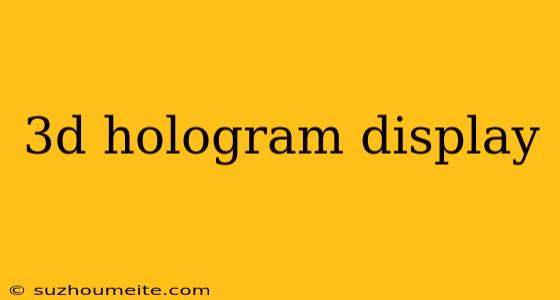3D Hologram Display: The Future of Visual Technology
The world of display technology has witnessed significant advancements in recent years, and one of the most promising developments is the 3D hologram display. This innovative technology has the potential to revolutionize the way we interact with visual content, providing an immersive and interactive experience like no other.
What is a 3D Hologram Display?
A 3D hologram display is a device that uses lasers, spatial light modulators, and holographic screens to project high-definition, three-dimensional images in mid-air. These images appear to float in space, allowing viewers to see them from any angle, and even interact with them in real-time.
How Does it Work?
The technology behind 3D hologram displays is based on the principles of holography, which involves recording the interference pattern of light waves. When a laser beam is directed at a holographic screen, it creates an interference pattern that reconstructs the original image in three dimensions. This allows the display to project 3D images with incredible accuracy and depth.
Applications of 3D Hologram Displays
The potential applications of 3D hologram displays are vast and varied, including:
Gaming
Imagine playing your favorite video game in stunning 3D, with characters and objects floating in mid-air. The immersive experience would be unparalleled, and the possibilities for interactive gameplay would be endless.
Education
3D hologram displays could revolutionize the way we learn, making complex concepts more engaging and interactive. Students could visualize molecular structures, explore virtual historic sites, or dissect virtual cadavers in breathtaking detail.
Healthcare
Doctors could use 3D hologram displays to visualize patient data, such as MRI scans or X-rays, in stunning detail. This could lead to more accurate diagnoses and better patient outcomes.
Entertainment
Imagine watching a movie or concert in 3D, with the performers or characters floating in mid-air. The experience would be unlike anything we've seen before, and would likely change the entertainment industry forever.
Challenges and Limitations
While 3D hologram displays hold immense promise, there are still significant challenges to overcome. These include:
Cost
The technology is still relatively expensive, making it inaccessible to many individuals and organizations.
Resolution
The resolution of current 3D hologram displays is not yet on par with traditional displays, resulting in a less-than-perfect viewing experience.
Content Creation
Creating high-quality, 3D holographic content is a complex and time-consuming process, which limits the availability of content.
Conclusion
The 3D hologram display is a revolutionary technology that has the potential to transform the way we interact with visual content. While there are still challenges to overcome, the possibilities are endless, and the future of display technology has never looked brighter. As the technology continues to evolve, we can expect to see widespread adoption across various industries, changing the game for entertainment, education, and more.
